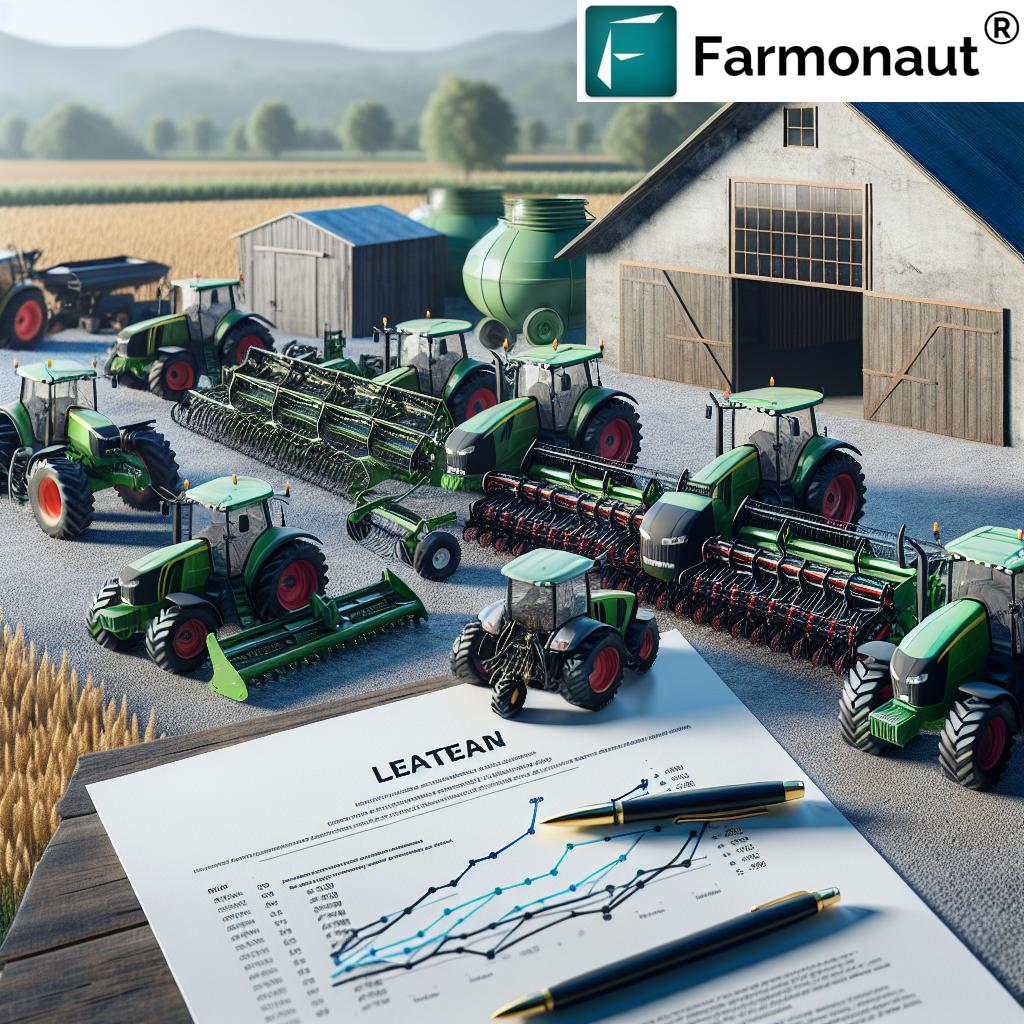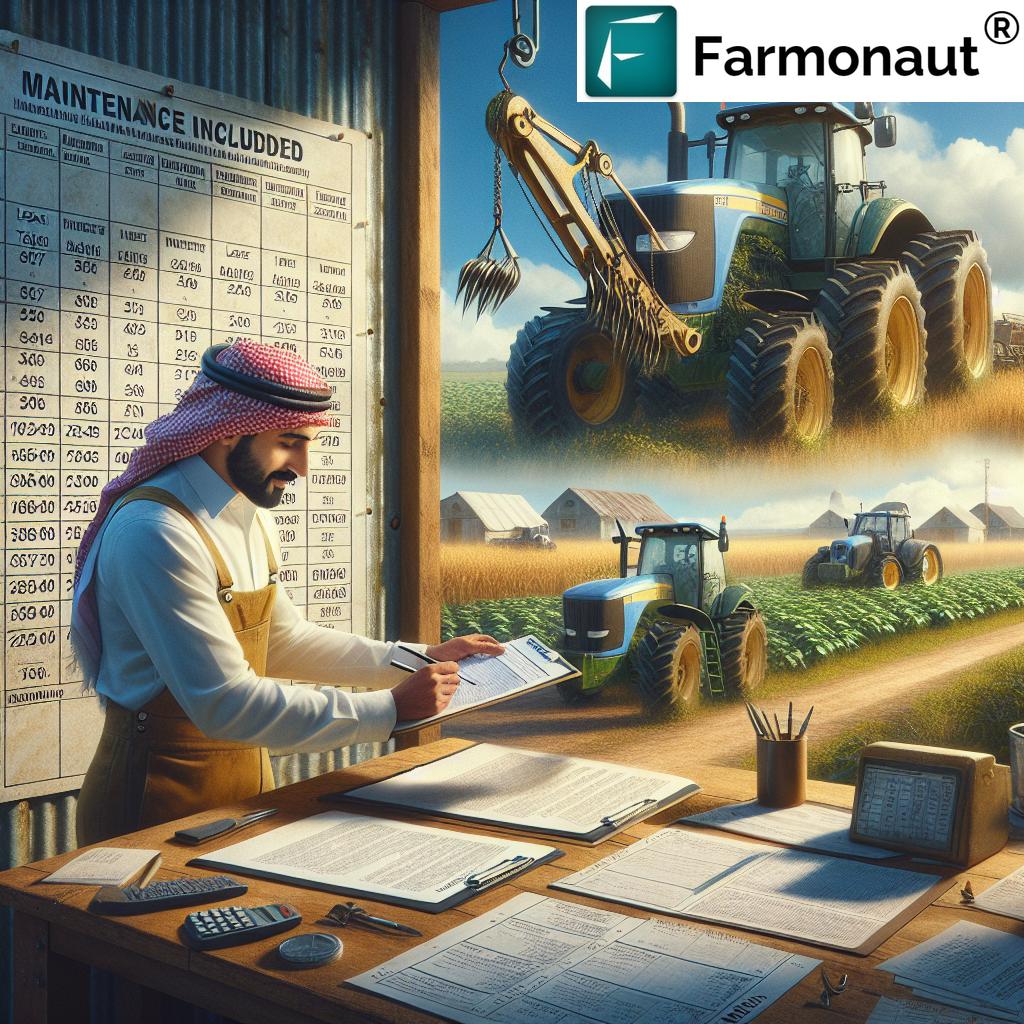Leasing Farm Equipment: 7 Powerful Benefits for Farmers
“Leasing farm equipment can reduce upfront costs by up to 60% compared to purchasing new machinery.”
Introduction
Farm equipment leasing has become a vital financial strategy for farmers aiming to optimize their agricultural operations. Navigating the lease vs purchase decision is essential for today’s agribusinesses, especially with advancing technology and fluctuating market demands. Leasing offers a flexible approach for farmers to access the latest technologies and equipment required for modern farming, without the high upfront investment often associated with purchasing machinery outright.
This comprehensive guide will explore in detail the advantages of leasing farm equipment, compare the long-term cost benefits of leasing farm equipment versus purchasing, examine typical farm machinery lease agreements, and discuss practical farm equipment lease vs buy decision criteria. We will provide key examples, highlight potential challenges, showcase critical tax benefits of leasing farm equipment, and include actionable advice for evaluating agricultural equipment leasing options. Our goal is to ensure every farmer, manager, or agri-entrepreneur makes an informed decision tailored to their farm’s unique operational and financial needs.
Throughout, we’ll weave in the latest industry insights, SEO-optimized content, practical checklists, and tables for easy comparison, alongside Farmonaut’s precision agriculture technologies that can enhance your leasing strategies. Whether you operate in the American Midwest or global agricultural hubs, these insights apply to small, mid-size, and large-scale farms alike.
Understanding Farm Equipment Leasing
Farm equipment leasing refers to a financial arrangement where a farmer or farm business obtains the use of necessary machinery for a specified period—typically through lease agreements—without committing to outright purchasing. This leasing structure allows for spreading costs over time, making it easier for farms to budget and allocate funds efficiently across various operational needs.
Commonly leased agricultural equipment includes:
- Tractors and combine harvesters
- Seeders and planters
- Sprayers and irrigation systems
- Ploughs, tillers, and cultivators
- Specialty equipment for horticulture, forestry, or aquaculture
With leasing, farmers agree to pay fixed or variable lease payments over the lease term, which may range from a short term farm equipment lease (e.g., one season) to a multi-year contract. The lease agreement specifies the usage limits, maintenance responsibilities (often including maintenance and repair coverage), and options for upgrades or purchasing at the end of the lease.
Key takeaway: Leasing agricultural equipment is distinctly different from renting due to longer term lengths and higher flexibility, and from purchasing due to no initial ownership—but with risk-mitigation, cost-management, and access to the latest technology.
7 Powerful Benefits of Leasing Farm Equipment
The advantages of leasing farm equipment extend beyond just financial relief. With changing dynamics in agricultural markets, farmers require flexible solutions for equipment acquisition, resource allocation, and adapting to technological innovation. Here are the seven most compelling benefits of leasing farm equipment:
“Over 45% of farmers now consider leasing to access the latest technology without long-term financial commitment.”
1. Lower Upfront Costs and Financial Flexibility
One of the most immediate cost benefits of leasing farm equipment is the lower upfront investment required. Rather than tying up substantial capital in machinery, leasing typically only needs the first month’s payment and, in some cases, a minimal security deposit (source: Southern AgCredit).
- Preserves working capital for other critical areas such as seed, fertilizer, labor, and expansion.
- Enables farmers to allocate funds dynamically, reducing dependency on loans or cramping cash flow during key seasonal operations.
- Initial investment is limited, making leasing accessible for small and medium farms.
This structure allows strategic scaling, especially as new operational needs emerge or crop cycles fluctuate.
2. Access to Latest Technology and Upgrades
The rapid pace at which agricultural technology evolves can make ownership risky—machines depreciate fast, and innovation quickly renders older models less efficient. Through leasing, farmers can:
- Access the latest technology by upgrading to new equipment at the end of each lease term (365retail.co.uk).
- Remain competitive and productive with the most current features—higher fuel efficiency, precision controls, IoT-enabled diagnostics, etc.
- Avoid the risk of technological obsolescence that often plagues equipment owners locked into older models.
For example, upgrading from a manual seeding tractor to a GPS-guided model can increase planting accuracy and save on seed costs—leasing makes such transitions accessible and affordable.
3. Tax Benefits of Leasing Farm Equipment
A crucial factor in the farm equipment lease vs buy decision is the tax benefits of leasing farm equipment (AgCountry):
- Lease payments can often be deducted as business expenses, reducing taxable income immediately instead of slower depreciation spread over years.
- Accelerated write-offs may be available, providing important financial relief at tax time.
- Consult a qualified accountant or agricultural finance expert to ensure you maximize these tax advantages for your local jurisdiction and specific farm structure.
4. Maintenance Included in Farm Equipment Lease
Maintenance and repair coverage is increasingly common in modern farm machinery lease agreements (Harvest Harmonies):
- Many leases include maintenance services—reducing financial burden from sudden breakdowns or heavy wear during peak seasonal periods.
- Coverage ensures the equipment remains in optimal working condition, contributing to reliability and peace of mind.
- This is a marked advantage over ownership, where unforeseen repair costs can disrupt budgeting and operational continuity.
Always review your lease agreement to understand exactly which maintenance services are included, scheduling, and responsibilities after accidental or abnormal damage.
5. Flexibility and Seasonal Optimization
Leasing is a highly flexible solution for matching operational needs with available equipment—for both short-term farm equipment leases and extended periods (Southern AgCredit).
- Customize lease terms to provide machinery only when necessary—minimizing idle inventory and matching planting, harvesting, or irrigation windows.
- Upgrade or change machinery if operational requirements shift from season to season (e.g., switching between row crops and specialty crops, or scaling for expansion projects).
- Avoid storage and depreciation costs by not holding idle equipment off-season.
This flexibility is a key reason why leases are favored for unpredictable or evolving operations compared to buying new machinery outright.
6. Strategic Financial Decision-Making
For farms operating on thin margins, every financial choice must be strategic. Leasing:
- Aligns with business and entrepreneurship goals by enabling rapid scale-up or down depending on the season or commodity prices.
- Reduces risk when testing new crops, expanding into unproven markets, or during times of market volatility.
- Allows for diversification and resource allocation—instead of being limited by a single large equipment purchase.
Leasing is also beneficial when it comes to preserving credit lines and enabling better relationships with agri-finance providers.
7. No Long-Term Commitment or Depreciation Risk
Farm machinery depreciates rapidly, and market values fluctuate with technology upgrades and environmental regulations. Leasing:
- Removes the risk of being stuck with outdated machinery as technology or regulations change.
- No hassle of selling used equipment, which can be time-consuming, expensive, and unpredictable in resale value.
- End-of-term options often include straightforward upgrades or replacements for minimal hassle.
Drawbacks and Key Considerations in Equipment Leasing
No business decision is without its potential drawbacks. While leasing offers significant benefits, it’s important to consider the following factors before signing a lease agreement:
No Ownership and Equity Building
By leasing instead of purchasing, farmers do not build equity in their equipment. There’s:
- No asset on your balance sheet: At the end of the lease, the equipment must usually be returned; you can’t sell it in the future.
- Long-term users may find this less beneficial compared to accumulating value via outright ownership and reselling machinery when upgrading.
Long-Term Cumulative Costs
While initial lease payments are lower, over an extended period the cumulative cost of leasing may exceed the purchase price of new equipment.
- For those who plan to use equipment long past the standard lease term, outright purchase may be more economical after several years.
- Always conduct a full life-cycle cost analysis when making your lease vs purchase decision.
Usage Restrictions and Penalties
Most lease agreements establish usage restrictions, such as annual or seasonal operational hour limits.
- Exceeding these can result in penalties, cutting into cost savings.
- Heavy or unexpected usage (e.g., during weather emergencies or bumper crop years) may exceed allowances.
Early Termination Penalties
Many lease agreements include significant penalties for early termination. If your farming operation changes unexpectedly (e.g., selling land, crop failure), breaking the lease can prove costly.
- Factor these risks into your decision, especially if you foresee volatility in operation scale or crop types over the lease period.
Potential for Technological Obsolescence
While leases allow regular upgrades, there remains a risk that the leased equipment becomes outdated before your contract ends. This can affect productivity or market competitiveness if newer, more efficient equipment is released mid-term.
- Negotiate clauses for flexible upgrades and periodic technology reviews.
Optimize the usage and scheduling of leased equipment with our Fleet and Resource Management Tools, designed to track operational hours, minimize downtime, and reduce overall machinery costs.
Types of Farm Equipment Lease Agreements
Choosing the right type of farm equipment lease is critical to maximizing benefits and minimizing drawbacks. Common lease agreement types include:
Operating Leases (Short-Term Equipment Lease Option)
- Short term farm equipment lease (typically 1–5 years)
- Lessor retains ownership of the equipment—after the lease term, equipment is returned
- Ideal for fast-moving technology and farmers seeking regular upgrades or who want little asset risk
- Lease payments are typically lower than a loan repayment on a purchase
Capital Leases (Finance Leases)
- Tend to be longer-term (usually 3–7 years)
- Often includes the option to purchase the equipment at lease end (for a residual value or nominal sum)
- Suitable for farmers who eventually want ownership and wish to build equity
- Some tax advantages may mirror outright purchasing (seek professional advice)
Key Clauses to Review in Farm Equipment Lease Agreements:
- Payment schedules and penalties
- Maintenance and repair responsibilities
- Upgrade and replacement options
- Buyout clause details
- Operational usage restrictions
- Insurance and liability details
Looking for more confidence in your lease or purchase process? Our Farmonaut Crop Loan and Insurance Verification tools can help financial institutions quickly verify crop health and acreage via satellite for a smoother loan or insurance application process.
Lease vs. Purchase: Key Factors for Farmers
To aid informed decision making, see our comparative table below highlighting core lease vs purchase considerations:
| Factor | Leasing | Purchasing |
|---|---|---|
| Upfront Cost | Low (5–20% of purchase price) | High (100% of asset value or down payment if financed) |
| Annual Payment | Consistent, predetermined lease payments | Varies by loan terms, may fluctuate with interest rates |
| Access to Latest Technology | Yes (easy upgrade at lease end) | No (locked into chosen model unless re-selling/upgrading) |
| Maintenance Responsibility | Usually included in lease; minimal out-of-pocket costs | Owner responsible for all maintenance and repairs |
| Flexibility | High—switch equipment or end lease as needs change | Low—must sell, trade, or store equipment |
| Tax Advantages | Payments often deductible as business expense | Depreciation and interest deductible |
| Asset Ownership | No ownership, no equity built | Full ownership and asset with equity value |
| End-of-Term Options | Upgrade, renew, or purchase at residual value | Continue usage, sell, or trade |
Evaluating Agricultural Equipment Leasing Options
The most successful leasing strategies stem from a careful, stepwise review of both operational and financial requirements. Here’s a recommended process for evaluating agricultural equipment leasing options:
1. Assess Your Farm’s Operational Needs
- List all machinery required for each growth stage, crop type, and season.
- Consider expansion or diversification plans—lease terms can often include scalable upgrades as your farm grows.
- Check if you require specialized or advanced equipment for new crops or sustainable farming practices.
2. Financial Analysis: Leasing vs Purchasing Farm Equipment
- Calculate total lease payments over the expected usage period.
- Compare with outright purchase cost (include maintenance, depreciation, repair, financing interest, resale value).
- Consult with an agricultural accountant to maximize tax benefits of leasing farm equipment.
3. Consult Advisors and Review Agreements Carefully
- Engage with financial/agricultural advisors familiar with your country’s farm equipment leasing norms.
-
Analyze the lease agreement for:
- Maintenance and repair provisions
- Penalties and usage restrictions
- Options for upgrades or purchase at lease end
- Early termination clauses
Leverage Large-Scale Farm Management Tools from Farmonaut to monitor equipment-affected zones, optimize field operations, and match machinery usage to actual vegetation health and yield trends for enhanced decision-making.
4. Align Lease Strategy with Long-Term Operational and Business Goals
- If you value regular upgrades and operational flexibility, leasing is an excellent fit.
- If you plan to use equipment for a decade or more, and desire equity, purchasing may be preferable.
- Leasing offers advantages for new ventures, rapidly changing crop types, or during equipment testing and pilot phases.
Farmonaut Technologies to Enhance Leasing Decisions
At Farmonaut, our mission is to empower farmers to maximize farm productivity while minimizing unnecessary costs across the entire crop cycle. Leasing fits perfectly into this vision—by combining precise data-driven insights with affordable, scalable agricultural technology solutions, we help farmers make informed leasing decisions across any operational context.
-
Carbon Footprinting Solutions
— Understand the environmental impact of leased equipment usage, making your farm more sustainable and regulatory-compliant. -
Blockchain-Based Product Traceability
— Leverage equipment data in end-to-end traceability for compliance and transparency in agri-supply chains. - Satellite-Based Crop Health Monitoring — Integrate precision data to schedule lease periods, minimizing idle time and aligning equipment usage with peak field activity.
- Jeevn AI Advisory System — Real-time guidance on input timing, irrigation, and optimal equipment deployment.
Our solutions are available as web, Android, and iOS apps, and seamlessly integrate into existing workflows. Fleet and resource management tools further optimize leased equipment scheduling and cost tracking for cooperatives and large-scale operators.
Learn more about our API integration for agricultural analytics and financial services here:
Farmonaut Satellite & Weather API
(with Developer Docs).
FAQs about Leasing Farm Equipment
What is the difference between leasing, renting, and purchasing farm equipment?
Leasing refers to a mid-to-long term contract for the use of agricultural equipment, typically 1–7 years, with fixed payments. Renting is short-term (days or weeks), often without maintenance included. Purchasing means outright ownership and all associated responsibilities.
How do I know if leasing is right for my farm?
Consider leasing if you want to minimize upfront costs, require access to the latest technology, or need operational flexibility. Conduct a detailed cost comparison and operational review to ensure leasing aligns with your business priorities.
Are tax benefits of leasing farm equipment significant?
Yes. Lease payments are often tax-deductible as business expenses, which can lower your taxable farm income. Details depend on country/local laws—always seek professional tax advice.
Does a farm equipment lease include maintenance?
Many modern lease agreements include all or part of maintenance and repairs. Ensure you review your contract for specific coverage details.
What happens at the end of my lease term?
You typically have three options: return the equipment, purchase it for a residual value, or upgrade to a new lease with the latest technology.
Can I lease specialized or advanced farm equipment?
Yes. Most lessors now offer GPS-equipped tractors, precision planters, drones, and more. Ensure the technology and model options suit your growing requirements.
Is leasing better for short-term or seasonal needs?
Absolutely. Leasing gives you flexibility to acquire machinery just for the season or reason needed, reducing idle inventory and cost.
Are there risks associated with leasing?
Main risks include penalties for early termination, usage limits, no asset equity, and potential technology obsolescence if a new upgrade is released during your lease—review all agreement terms carefully.
Does Farmonaut lease farm machinery?
No, we do not lease or sell farm equipment. Our focus is advanced, satellite-based farm management tools and data-driven advisory solutions to optimize your farming operations, including equipment usage.
How can I track and optimize my leased equipment?
Our fleet and resource management platform helps automate equipment scheduling, monitor operational hours, and reduce costs while maximizing field productivity.
Conclusion
Leasing farm equipment is emerging as a strategic financial decision for farms of all sizes—enabling access to cutting-edge technology with minimal upfront costs, enhanced operational flexibility, and valuable tax advantages for modern agribusinesses. While leasing removes the burden of equipment depreciation and large initial investments, it’s essential to evaluate all terms, understand potential penalties and restrictions, and align lease agreements to the specific needs of your operation.
By leveraging tools like satellite-based crop monitoring, AI-driven advisory, and digital resource management, we at Farmonaut support farmers in making informed lease vs purchase decisions that improve productivity while safeguarding financial health. Whether you’re considering a short term farm equipment lease or a longer strategic contract, always review the agreement in detail, compare lifetime costs, and align your decision with both current requirements and future business ambitions.
Explore new possibilities and optimize every harvest—visit our platform or contact our team to learn more about integrating technology with your leasing strategy today.
Farmonaut Subscriptions
Ready to boost your farm’s profitability and make the most of your leasing strategy?
Explore Farmonaut’s affordable, data-driven subscription models below:
For guidance, technical support, or a free demo, connect with us through our web and mobile apps. Unlock the true value of every acre—start your journey with Farmonaut today.












